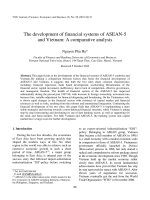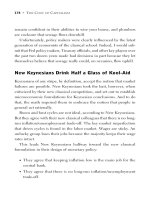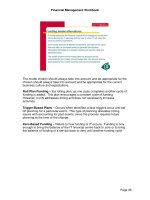The Financial Management Toolkit The Missing Financial Management Planning Process Theory and Tools Guide ITIL Compliant_3 potx
Bạn đang xem bản rút gọn của tài liệu. Xem và tải ngay bản đầy đủ của tài liệu tại đây (243.63 KB, 13 trang )
Financial Management Workbook
Page 26
The model chosen should always take into account and be appropriate for the
chosen should always take into account and be appropriate for the current
business culture and expectations.
Roll Plan Funding – Ina rolling plan, as one cycle completes another cycle of
funding is added. This plan encourages a constant cycle of funding.
However, it only addresses timing and does not necessarily increase
accuracy.
Trigger-Based Plans – Occurs when identified critical triggers occur and set
off planning for a particular event. This type of planning alleviates timing
issues with accounting for past events, since the process requires future
planning at the time of the change.
Zero-Based Funding – Refers to how funding of IT occurs. Funding is only
enough to bring the balance of the IT financial centre back to zero or to bring
the balance of funding of a service back to zero until another funding cycle.
Financial Management Workbook
Page 27
A number of steps can be completed while generating a BIA. Some of the
high level activities are as follows:
1. Arrange resources from the business and IT that will work together on the
analysis
2. Identify all of the top candidate services for designation as critical,
secondary and tertiary
3. Identify core analysis points for use in assessing risk and impact, e.g.
• Lost sales revenue
• Fines
• Failure risk
• Lost Productivity
• Lost opportunity
• Number of users impacted
• Visibility to shareholders, management etc
• Risk of service obsolescence
• Harm to reputation among customers, shareholders and regulatory
authorities.
4. With the business, weight the identified elements of risk and impact.
5. Score candidate services against the weighted elements of risk and impact
and total their individual risk scores.
6. Generate a list of services in order of risk profile.
7. Decide on a universal time period with which to standardize the translation
of service outage to financial cost.
8. Calculate the financial impact of each service being analyzed within the BIA
using agreed methods, formulas and assumptions.
9. Generate a list of services in order of financial impact
10. Utilize the risk and financial data generated to create charts that illustrate
the company’s highest risk applications that also carry the greatest financial
impact.
Financial Management Workbook
Page 28
Financial Management Workbook
Page 29
It is not unexpected that companies seek to apply the ROI in deciding to adopt
service management. ROI is appealing because it is self-evident. The
measure either meets or does not meet a numerical criterion. The challenge
is when ROI calculations focus on the short-term. The application of service
management has different degrees of ROI, depending on business impact.
Furthermore, there are often difficulties in quantifying the complexities
involved in implementations.
Financial Management Workbook
Page 30
Service management by itself does not provide any of the tactical benefits that
business managers typically budget for. One of the greatest challenges for
those seeking funding for ITIL projects is identifying a specific business
imperative that depends on service management.
Financial Management Workbook
Page 31
Business case – means to identify business imperatives that depend on
service management.
Pre-program ROI – Techniques for quantitatively analyzing an investment in
service management.
Post-program ROI – techniques for retroactively analyzing an investment in
service management.
We will look at each concept in more detail throughout the presentation.
Financial Management Workbook
Page 32
There is an ITIL Version 3 Sample Business Case Structure available on
page 97.
Financial Management Workbook
Page 33
Objectives should start broadly. For example,
The business objectives for commercial provider organizations are usually the
objectives of the business itself, including financial and organizational
performance.
The business objectives for not-for-profit organizations are usually the
objectives for the constituents, population or membership served as well as
financial and organizational performance.
An example of ITIL Version 3 Common Business Objectives is available
on page 99.
Financial Management Workbook
Page 34
It is easy for a business case to focus on financial analysis and neglect non-
financial impacts. The end result is a business case that is not as convincing
as it should be. By incorporating business impacts linked to business
objectives, a business case is more compelling.
Examples of how ‘Single business impact can affect multiple business
objectives’ and ‘Multiple business impacts can affect a single business
objective’ are available on pages 101 and 103.
Financial Management Workbook
Page 35
Financial Management Workbook
Page 36
Screening decisions relate to whether a proposed service management
initiative passes a predetermined hurdle, minimum return for example.
Preference decisions, on the other hand, relate to choosing from among
several competing alternatives. Selecting between an internal Service
Improvement Plan (SIP) and a service sourcing program is an example.
Financial Management Workbook
Page 37
NPV is preferred for screening decisions. IRR is preferred for preference
decisions.
Under the NPV method, the programs cash inflows are compared to the cash
outflows. The difference, called net present value, determines whether or not
the investment is suitable. Whenever the net present value is negative, the
investment is unlikely to be suitable.
An Example of NPV Decisions is available on page 105.
Financial Management Workbook
Page 38
For service management programs, the NPV method has several advantages
over the IRR method:
• NPV is generally easier to use
• IRR may require searching for a discount rate resulting in an NPV or
zero.
• IRR assumes the rate of return is the rate of return on the program, a
questionable assumption for environments with minimal service
management program experience.
• When NPV and IRR disagree on the attractiveness of the project, it is
best to go with NPV. It makes the more realistic assumption about the
rate of return.









